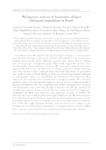Por favor, use este identificador para citar o enlazar este ítem:
http://www.alice.cnptia.embrapa.br/alice/handle/doc/1063871Registro completo de metadatos
| Campo DC | Valor | Lengua/Idioma |
|---|---|---|
| dc.contributor.author | PASSO, J. F. | pt_BR |
| dc.contributor.author | ZUCCHI, R. A. | pt_BR |
| dc.contributor.author | RONCHI-TELES, B. | pt_BR |
| dc.contributor.author | BARR, N. B. | pt_BR |
| dc.contributor.author | MCPHERON, B. A. | pt_BR |
| dc.contributor.author | ARAÚJO, E. | pt_BR |
| dc.contributor.author | ADAIME, R. | pt_BR |
| dc.contributor.author | SILVA, J. G. | pt_BR |
| dc.date.accessioned | 2017-02-13T11:11:11Z | pt_BR |
| dc.date.available | 2017-02-13T11:11:11Z | pt_BR |
| dc.date.created | 2017-02-13 | pt_BR |
| dc.date.issued | 2016 | pt_BR |
| dc.identifier.citation | In: MEETING OF THE TEPHRITID WORKERS OF THE WESTERN HEMISPHERE, 9th., 2016. Buenos Aires. Book of Abstracts... [Buenos Aires: FAO: AIEA, 2016]. p. 202. | pt_BR |
| dc.identifier.uri | http://www.alice.cnptia.embrapa.br/alice/handle/doc/1063871 | pt_BR |
| dc.description | Introduction: The West Indian fruit fly, Anastrepha obliqua, is a major pest of tropical fruits infesting a wide variety of hosts and in Brazil it is the second most frequent species in the genus. Molecular analyses have shown that A. obliqua does not represent a monophyletic group. This would suggest the need for more detailed studies about population structure. We sequenced a portion of genomic regions COI, ITS, Period and ND6 from A. obliqua gathered in Brazil. Methods: Forty two specimens were collected from fruits and traps from 25 geographic sites in eleven states in Brazil. Methods: DNA was isolated and a partial fragment of each genomic region was amplified by the Polymerase Chain Reaction, then sequenced. The sequences were concatenated in a sequence matrix. We performed partition analysis for each genomic region to choose the best evolution model. A Bayesian phylogenetic tree was constructed and analyses for population structure and demographics were estimated. Results: A fragment of 2,184 bp contained 78 variable sites e genetic distance of 2.8% between clades. A total of 33 haplotypes (designated H1-H33) were observed with haplotype diversity of 0.9884. We observed two clades. Clade I consisted of mostly Northeastern collections and clade II of collections from the Northern region. We saw that haplotypes recovered from individuals gathered in Pará and Amapá were present in both clades. Conclusion: Our results show high haplotype diversity and two clusters of A. obliqua in the phylogenetic tree with exclusive haplotypes in each region, which can have resulted from a decrease in gene flow between populations due to geographic distance. | pt_BR |
| dc.language.iso | por | pt_BR |
| dc.rights | openAccess | pt_BR |
| dc.subject | Diversidade genética | pt_BR |
| dc.subject | Genetic diversity | pt_BR |
| dc.subject | India Ocidental | pt_BR |
| dc.subject | West Indian | pt_BR |
| dc.subject | Fruit fly | pt_BR |
| dc.subject | Plant pest | pt_BR |
| dc.subject | Mosca da fruta | pt_BR |
| dc.title | Phylogenetic analysis of Anastrepha obliqua (Macquart) populations in Brazil. | pt_BR |
| dc.type | Resumo em anais e proceedings | pt_BR |
| dc.date.updated | 2017-02-13T11:11:11Z | pt_BR |
| dc.subject.thesagro | Praga de planta | pt_BR |
| riaa.ainfo.id | 1063871 | pt_BR |
| riaa.ainfo.lastupdate | 2017-02-13 | pt_BR |
| dc.contributor.institution | JOSEANE FERNANDA PASSOS, UESC; ROBERTO ANTONIO ZUCCHI, ESALQ/USP; BEATRIZ RONCHI-TELES, INPA; RAUL RUIZ-ARCE, United States Department of Agriculture, Texas; BRUCE A. MCPHERON, Ohio State University; ELTON ARAUJO, UFERSA; RICARDO ADAIME DA SILVA, CPAF-AP; JANISETE GOMES SILVA, UESC. | pt_BR |
| Aparece en las colecciones: | Resumo em anais de congresso (CPAF-AP)  | |
Ficheros en este ítem:
| Fichero | Descripción | Tamaño | Formato | |
|---|---|---|---|---|
| CPAFAP2016PhylogeneticanalysisofAnastrephaobliqua.pdf | 53.53 kB | Adobe PDF |  Visualizar/Abrir |









